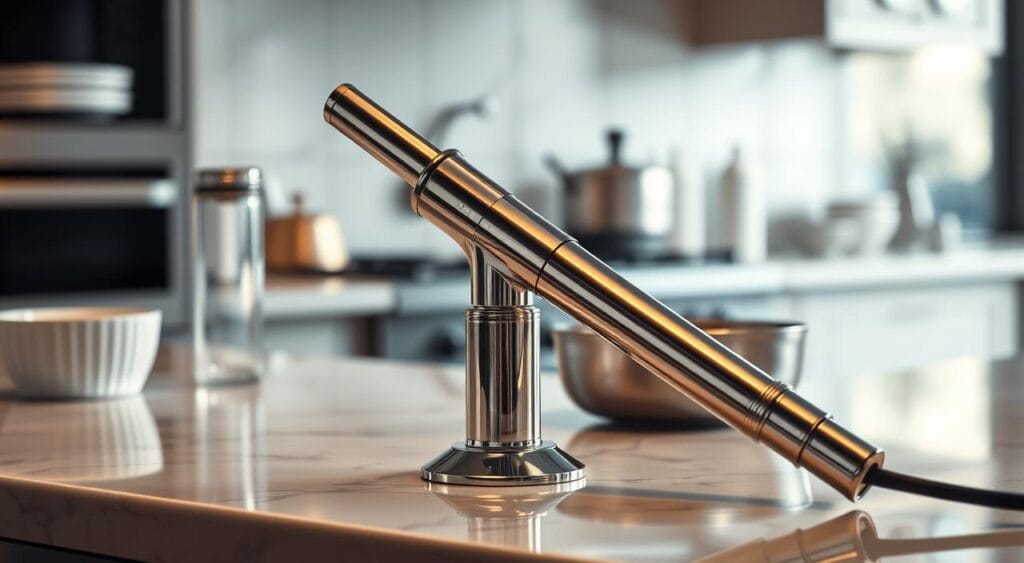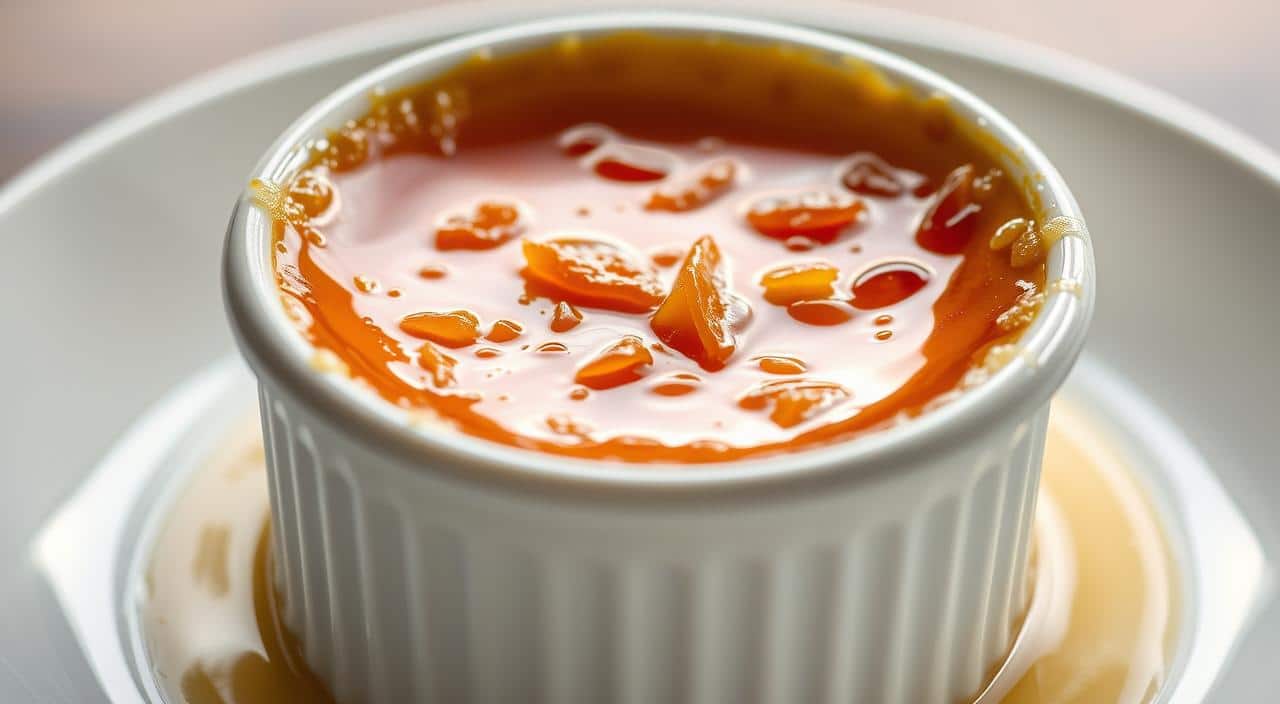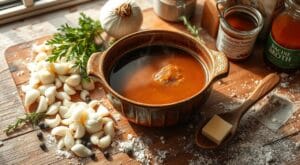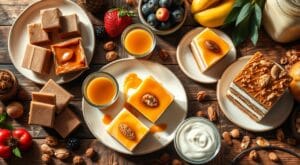Jump to:
Estimated reading time: 15 minutes
Table of contents
How to make a creme brulee top? Crème brûlée is a simple yet elegant dessert that will impress your guests. It has a creamy custard base and a perfectly caramelized sugar topping. Making this French classic may seem intimidating, but it’s easier than you think.
With the right techniques, you can easily create a crisp, golden-brown crust. In this guide, we’ll show you how to achieve the perfect crème brûlée top. We’ll cover everything from selecting the right ingredients to using a torch with precision.
How to make a creme brulee top? Key Takeaways
- Crème brûlée is made with just a few simple ingredients: heavy cream, egg yolks, sugar, and vanilla.
- The key to a perfect crème brûlée top is evenly distributing a thin layer of granulated sugar and caramelizing it with a kitchen torch.
- Using the right torch and technique is crucial for achieving a consistent, golden-brown caramelized crust.
- Proper cooling and preparation of the custard base is essential for a smooth, crack-free texture.
- Experimenting with different sugar types and flavors can add a unique twist to your crème brûlée.
Introduction
Crème brûlée is a classic French dessert known for its creamy custard and caramelized sugar topping. Getting the perfect caramelized top can seem hard for home cooks. But, with the right techniques, anyone can make this rich dessert.
We’ll explore how to make the perfect crème brûlée top. We’ll cover the key ingredients, tools, and steps for a great result. This guide is for both experienced bakers and beginners, to help you improve your crème brûlée.
This guide will teach you about the caramelized crust and how to avoid common mistakes. It will help you appreciate the details of this favorite dessert. Let’s start our journey to making a crème brûlée top that will wow your guests.
Understanding the Basics of a Perfect Crème Brûlée Top
Making a perfect crème brûlée top is about finding the right mix. You need a crisp, caramelized top and a smooth custard underneath. Knowing the right ingredients and techniques is key to this classic French dessert.
How to make a creme brulee top? What Makes a Good Crème Brûlée Top?
A great crème brûlée has a caramelized sugar topping and a creamy custard. The top should be golden and crack when you bite into it. This reveals the creamy filling inside.
How to make a creme brulee top? Key Ingredients for the Caramelized Crust
- Heavy cream: Provides the creamy base for the custard
- Egg yolks: Gives the custard its silky texture and velvety feel
- Granulated sugar: Essential for the caramelized crust
- Vanilla: Adds to the dessert’s flavor
Importance of Sugar Type and Distribution
The sugar type and how it’s spread on the custard matter a lot. Granulated sugar is best because it caramelizes evenly. It’s important to spread the sugar evenly to avoid uneven caramelization.
| Sugar Type | Impact on Crème Brûlée Top |
|---|---|
| Granulated Sugar | Ideal for even caramelization and a crisp, golden-brown finish |
| Brown Sugar | Adds a richer, more complex flavor to the caramelized crust |
| Demerara Sugar | Provides a coarser, crunchier texture to the caramelized top |

The perfect crème brûlée top comes from balancing ingredients and techniques. This creates a delicious contrast of textures and flavors.
Tools Needed for the Perfect Crème Brûlée Top
To get the perfect crème brûlée top, you need the right tools. The most important one is a brulee torch. This tool helps you caramelize the sugar evenly without burning the custard. Look for a kitchen torch for caramelizing that lets you control the flame well.
How to make a creme brulee top? Choosing the Right Torch
The best torch for crème brûlée has a few key features:
- Adjustable flame for precise control
- Comfortable, ergonomic grip for easy handling
- Sturdy construction to withstand repeated use
- Safety features like an automatic shut-off or locking mechanism
How to make a creme brulee top? How to Use a Torch Safely
When using a torch for crème brûlée, safety is key. Hold the torch at a slight angle, about 6-8 inches from the custard. Move it slowly and evenly to caramelize the sugar. Don’t hold the flame in one spot for too long to avoid overcooking the custard.
How to make a creme brulee top? Alternatives to a Kitchen Torch
If you don’t have a brulee torch, there are other ways to get a perfect caramelized top:
- Broiler: Place the crème brûlée dishes under a preheated broiler, keeping a close eye to prevent burning.
- Culinary Heat Gun: These gadgets can be used to evenly caramelize the sugar topping.
- Oven-Safe Brulee Dishes: Some dishes are made to be placed directly under the broiler, so you don’t need a torch.
Choose any method you like, but aim for a crisp, golden-brown caramelized layer. This layer should contrast beautifully with the silky custard beneath.

How to Prepare the Crème Brûlée Before Topping
To get the perfect crème brûlée top, start with a well-prepared custard base. Before adding the caramelized sugar, cool the custard and get it ready for topping.
Cooling the Custard Properly
After baking, let the custard cool completely. First, let it reach room temperature, which takes about 1 hour. Then, put the ramekins in the fridge and chill for at least 2 hours. This ensures the custard is fully set.
Prepping the Custard for Caramelization
When it’s time to caramelize the top, the custard should be smooth in the ramekins. Use a spoon to smooth the surface and remove air bubbles. This makes the caramelization even.
Tips for Avoiding Cracks in the Custard
Cracks in the custard are common, but you can avoid them. Don’t overbake the custard. Cool it slowly in the fridge to prevent cracking. Also, remove air bubbles before chilling for a smooth texture.
| Ingredient | Amount |
|---|---|
| Heavy Cream | 1 1/4 cups (300ml) |
| Whole or Low-Fat Milk | 1/2 cup (125ml) |
| Sugar for Custard | 1/3 cup (70g) |
| Sugar for Caramelizing | About 4 tablespoons |
| Vanilla Bean or Paste | 1/2 bean or 1/2 teaspoon |
| Egg Yolks | 4 large |

“Letting the custard cool to room temperature and then chilling it in the refrigerator for at least 2 hours is crucial for setting the texture.”
Step-by-Step Guide to Making the Perfect Crème Brûlée Top
Getting the perfect crème brûlée top is about finding the right balance. You want a crisp, caramelized top and a creamy inside. Follow these easy steps to make a crème brûlée that will wow your guests.
Step 1: Evenly Distributing the Sugar
Begin by sprinkling a thin layer of granulated sugar over the chilled custard. Use a small spoon or sifter to spread it evenly. This ensures a golden-brown crust all over.
Step 2: Torch Technique for Even Caramelization
Then, use a kitchen torch to caramelize the sugar. Hold the flame 2-3 inches away and move it in circles. This method prevents hot spots and ensures even caramelization.
Step 3: Achieving the Ideal Golden-Brown Finish
Watch the sugar closely as you torch it. Stop when it’s a consistent golden-brown. This way, you get a crisp crust without burning the custard. With practice, you’ll get it right every time.
“The crème brûlée top turned out beautifully – it was a crisp, golden shell that cracked perfectly when I tapped it with my spoon. This recipe is a keeper!”
– Sarah, Satisfied Crème Brûlée Maker
Common Mistakes to Avoid When Making a Crème Brûlée Top
Making a perfect crème brûlée top is all about balance. You need caramelized sugar and a smooth custard. Even experienced chefs can make mistakes that spoil the dish. Let’s look at these common errors and how to steer clear of them for a top-notch crème brûlée.
Burning the Sugar Too Quickly
Burning the sugar too fast is a common mistake. This happens when you hold the torch in one spot for too long. The sugar turns bitter. To prevent this, keep the torch moving all over the surface, caramelizing the sugar evenly.
Uneven Caramelization Issues
Uneven caramelization can also ruin your crème brûlée top. If you miss spots or don’t torch the sugar enough, it looks patchy. Make sure to move the torch in circles, covering the whole area for a golden-brown crust.
Using Too Much or Too Little Sugar
The right amount of sugar is key. Too much makes the top too sweet and thick. Too little sugar means no satisfying crunch. Go for a thin, even sugar layer for the best texture and taste.
“The key to a perfect crème brûlée top is achieving a crisp, caramelized layer that complements the smooth, creamy custard beneath. Avoiding these common mistakes will ensure your crème brûlée is a true culinary delight.”
Variations for the Perfect Crème Brûlée Top
While the classic crème brûlée top uses granulated white sugar, there are several delightful variations you can explore to elevate this decadent dessert. One such option is to use brown sugar, which can provide a richer, more complex flavor profile. The warm, caramelized notes of brown sugar perfectly complement the creamy custard base.
Adding Flavors Like Cinnamon or Citrus Zest
Another way to add depth and interest to the crème brûlée top is by incorporating spices or citrus zest. A sprinkle of ground cinnamon or a dusting of orange or lemon zest can transform the classic crème brûlée into a truly captivating experience. These subtle flavor additions can balance the sweetness and create a more sophisticated taste.
Creating a Thicker or Thinner Caramelized Layer
The thickness of the caramelized layer on top of the crème brûlée is a matter of personal preference. By adjusting the amount of sugar used and the torch technique, you can achieve a thicker, more substantial crust or a thinner, more delicate one. Experiment with the sugar quantity and the duration and intensity of the torch application to find your ideal crème brûlée top.
| Variation | Ingredient/Technique | Flavor Profile |
|---|---|---|
| Brown Sugar Crème Brûlée | Use brown sugar instead of white sugar for the topping | Richer, more complex caramelized flavor |
| Spiced Crème Brûlée | Add ground cinnamon, nutmeg, or other spices to the sugar topping | Warm, aromatic notes that balance the sweetness |
| Citrus-Infused Crème Brûlée | Incorporate grated lemon, orange, or lime zest into the sugar topping | Bright, refreshing flavors that complement the rich custard |
By exploring these variations, you can unlock new flavor dimensions and tailor the crème brûlée top to your personal preferences, creating a truly unique and indulgent dessert experience.
“The key to a perfect crème brûlée top is striking the right balance between a crisp, caramelized crust and a creamy, velvety custard underneath.” – Chef Isabelle, Culinary Innovator
Storing and Reheating Crème Brûlée with the Perfect Top
Keeping the caramelized top crisp is key when storing and reheating crème brûlée. The right methods help you enjoy a crunchy top even after it’s chilled.
How to Store Without Losing the Crunch
To keep your crème brûlée’s sugar crust perfect, store each ramekin right. Wrap each one tightly in plastic wrap or foil to block air. This air can make the caramel soft. Don’t stack the ramekins, as this can ruin the top layer.
Can You Re-Caramelize the Top After Storing?
Yes, you can re-caramelize the top of chilled crème brûlée. But, add sugar and torch it just before serving for the best taste and crunch. Refrigeration and reheating can make the sugar dissolve or lose its shine. So, reapplying sugar and torching it is the best way to get that golden-brown crust.
Best Practices for Serving After Refrigeration
Let chilled crème brûlée sit at room temperature for 5-10 minutes before adding sugar and torching. This makes the custard warm and the caramelized layer melts well. Enjoy your stored creme brulee with perfect top by reheating creme brulee without losing crunch and re-caramelizing creme brulee after storage for the ultimate serving creme brulee after refrigeration experience.
Nutritional Information of a Crème Brûlée Top
The caramelized sugar topping is the star of crème brûlée. It adds a unique texture and sweetness. But, it also brings a lot of calories and sugar to the dessert. A tablespoon of sugar has about 50 calories, so the sugar on top can add up fast.
Calories in the Sugar Layer
The calories in the sugar topping depend on how much is used. A typical recipe uses 1-2 teaspoons of sugar per serving. This adds 50-100 calories to the dessert.
Impact of Different Sugars on Nutrition
Choosing different sugars can change the nutritional value of the crème brûlée top. The custard base is already high in fat and calories. But, using less refined sugars might lower the calories and sugar in the topping.
Lightening Up the Crème Brûlée Top
- Use less sugar on top of the custard, just enough for a thin, crisp layer.
- Try healthier sweeteners like granulated stevia or erythritol. They have fewer calories but still taste like caramel.
- Look for lighter crème brûlée recipes. They use less cream and more milk, which cuts down on calories and fat.
“Crème brûlée is an indulgent dessert, but with a few adjustments, you can enjoy the delightful caramelized topping without overindulging.”
Enhancing the Experience: Serving Suggestions for Crème Brûlée
Crème brûlée is a decadent treat that can be made even better with the right sides. Try it with fresh berries, citrus fruits, or tropical fruits like mango or pineapple. These add a refreshing contrast to the creamy custard. Serving it with a sweet dessert wine, like Sauternes, or a strong coffee or espresso can also enhance your meal.
Pairing with Fresh Fruits
The creaminess of crème brûlée goes well with tart and juicy fruits. Serving it with berries like raspberries, blackberries, or blueberries is a great choice. The fruit’s vibrant colors and flavors make a stunning contrast to the golden caramel on top.
Ideal Drinks to Accompany Crème Brûlée
- Sauternes: A sweet, dessert wine with honey and dried fruit notes that match the custard’s richness.
- Strong Coffee or Espresso: A dark roast coffee or espresso shot adds a bold contrast to the creaminess.
- Port: A tawny or ruby port adds a warm, nutty flavor that pairs well with the caramelized sugar.
Presentation Tips for Impressing Guests
For a show-stopping presentation, torch the sugar topping right at the table. The flame and the crunch of caramelizing sugar will wow your guests. Add a sprig of mint or a dusting of powdered sugar for a touch of elegance.
| Serving Suggestion | Benefit |
|---|---|
| Pairing with Fresh Berries | Provides a refreshing contrast to the rich custard |
| Serving with Sauternes Wine | Enhances the overall dining experience with complementary flavors |
| Torching the Sugar Topping Tableside | Creates a dramatic presentation and satisfying crunch |
“The perfect crème brûlée is a symphony of flavors and textures, where the cool, velvety custard meets the crisp, caramelized topping. With the right accompaniments, it becomes an unforgettable culinary experience.”
FAQ: How to make a creme brulee top?
Crème brûlée is a French dessert loved for its crispy caramel top and creamy custard. Getting the top just right is key. Let’s explore the most asked questions about this part.
What’s the Secret to a Flawless Crème Brûlée Top?
The secret is spreading sugar evenly and caramelizing it slowly. Use a kitchen torch to get it golden brown. This makes the top crunchy and perfect.
Can I Use Brown Sugar Instead of White Sugar?
Yes, you can! Muscovado sugar gives a richer flavor. Its molasses makes the caramel taste more complex.
How Do I Avoid Cracks in the Custard?
To avoid cracks, cool the custard slowly. Then, chill it in the fridge. This helps it set smoothly without cracks.
Can I Reheat the Crème Brûlée Top After Storing?
Yes, you can re-caramelize the top. Sprinkle sugar on the chilled custard and torch it again. This brings back the crunchy top.
What Are Some Tasty Serving Suggestions?
Try it with fresh berries like raspberries or blackberries for a burst of flavor.
Add a dollop of whipped cream or a sprinkle of nutmeg for extra indulgence.
Pair it with a strong espresso or sweet dessert wine for a perfect match.
Getting the crème brûlée top right takes practice and the right ingredients. With some effort, you’ll make this French classic with a stunning caramelized crust.
Conclusion: Mastering the Art of the Perfect Crème Brûlée Top
Getting the perfect crème brûlée top is an art that needs practice. But the result is so worth it. By knowing the right ingredients and techniques, and using the right tools, you can impress your guests. Each step, from spreading the sugar to mastering the torch, is key for that perfect caramelized finish.
This guide will help you perfect the crème brûlée top. You’ll enjoy the creamy custard in every bite. Whether you’re experienced or new to French desserts, these tips will take your crème brûlée to the next level. So, get your torch ready, preheat your oven, and start mastering the art of the perfect crème brûlée top.
Remember, mastering the crème brûlée top is about practice, trying new things, and paying attention to details. With each try, you’ll get better and more confident. You’ll get that golden-brown finish that makes this dessert a showstopper. Enjoy the journey, have fun, and relish the delicious outcome of your hard work.






